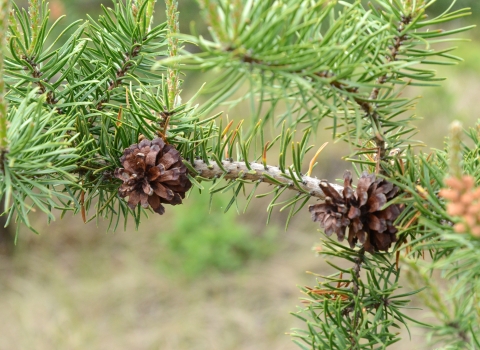In 2022, we celebrated the 150th anniversary of the National Fish Hatchery System, the premier aquaculture system in the world. The System was created in 1872 with the original goal of boosting production of fish to support commercial fisheries and feed communities. Over the years, the System has evolved to meet the varying needs of conservation and in addition to our long-term commitment supporting recreational, commercial, and subsistence fishing we are also focused on conserving at-risk, threatened, or endangered species.
The Fish and Aquatic Conservation program continues to evolve as well. We employ the latest advances in fields like genetics, physiology, population modeling, and aquatic habitat design to ensure healthy environments for both captive and wild aquatic species populations. Our invasive species invasive species
An invasive species is any plant or animal that has spread or been introduced into a new area where they are, or could, cause harm to the environment, economy, or human, animal, or plant health. Their unwelcome presence can destroy ecosystems and cost millions of dollars.
Learn more about invasive species program continues to lead with early detection and monitoring systems to prevent and limit the impact of invasive species. And our more than 1,200 dedicated permanent, term, and seasonal employees nationwide work to ensure America’s fisheries are among the world’s richest in abundance and diversity.
On page five, we show how all the Fish and Aquatic Conservation pieces work together. The programs build on the science, innovation, and creativity of its staff and offices to address current and future challenges of mitigating climate change climate change
Climate change includes both global warming driven by human-induced emissions of greenhouse gases and the resulting large-scale shifts in weather patterns. Though there have been previous periods of climatic change, since the mid-20th century humans have had an unprecedented impact on Earth's climate system and caused change on a global scale.
Learn more about climate change , preventing and managing invasive species, reconnecting waters, restoring habitats, and removing barriers to accessing nature
Enjoy the 2022 Fish and Aquatic Conservation Annual Report.
Dave Miko, Acting Assistant Director, Fish and Aquatic Conservation
The report tells the story of how we are conserving fish and other aquatic wildlife and restoring the freshwater habitats they rely on.
Hatching Success - The U.S. Fish and Wildlife Service’s National Fish Hatchery System uses aquaculture to raise fish and aquatic species for successful release and survival in natural settings. Our mission is to restore and support wild populations of aquatic animals through responsible and effective conservation aquaculture and applied science.
Restoring Our Rivers - Fish and Wildlife Conservation Offices work on aquatic species and habitat conservation projects across the country. Staff biologists provide technical assistance to tribes and collaborate on fishery restoration efforts. They also conduct scientific studies into fishery problems, restore habitat, and coordinate conservation efforts with partners to conserve migratory fish that cross multiple jurisdictions. Habitat loss, fragmentation, and degradation are some of the primary factors in the decline of native species, while threats from pollution and climate change are worsening water and habitat quality. To combat these threats, Fish and Wildlife Conservation Offices work with Tribes, states, and other partners to identify conservation goals restore aquatic habitat.
Applying Science to Conservation Challenges - The U.S. Fish and Wildlife Service’s Fish and Aquatic Conservation program is advancing cutting-edge technologies across the country that will shape the future of aquatic conservation for years to come. Our national network of fish hatcheries, fish technology centers, fish health centers, fish and wildlife conservation offices, and the Aquatic Animal Drug Approval Partnership use applied science and technology to steer our conservation practices.
Protecting Our Waters - Aquatic invasive species cause tremendous harm to our environment, our economy, and our health. They can drive out and eat native plants and wildlife, spread diseases, and damage infrastructure. We work to protect our waterways and the communities that depend on them from the threat of invasive species through partnerships, grants, and supporting the work of the Aquatic Nuisance Species Task Force.
Fulfilling Tribal Trust and Subsistence Responsibilities - Natural resource management programs operated by Tribes protect the spiritual, cultural, medicinal, subsistence, recreational, and economic needs of their communities. The Fish and Aquatic Conservation program is a shared steward with Tribes of many of these incredible natural and cultural resources.
Improving Access - Everyone deserves access to clean, safe, and local opportunities to connect with nature, and throughout the pandemic people sought these experiences in record numbers. Fish and Aquatic Conservation works to increase access to recreation by collaborating with industry, associations, and Friends Groups, as well as other federal agencies and state and Tribal governments.
In 2022...
- The Fish and Aquatic Conservation program provided over $63 million in financial assistance to restore and conserve aquatic resources.
- 71 hatcheries that make up the National Fish Hatchery System raised and stocked over 118 million fish to support recreational fishing, Tribal subsistence fisheries, and the recovery and restoration of imperiled species.
- 51 Fish and Wildlife Conservation Offices worked to monitor and control invasive species, protect imperiled species, evaluate native fish stocks and their habitats, and work with our partners to solve conservation problems.
- 6 Fish Health Centers worked on the front lines, preventing the spread of aquatic viruses, keeping our wild and hatchery fish healthy, and providing technical assistance to federal, state, and Tribal partners as well as to the private aquaculture industry.
- 7 Fish Technology Centers guided science and technology that is foundational to species and habitat conservation in the U.S. and develop new techniques to solve problems in hatchery operations and aquatic resource management.
- The Aquatic Animal Drug Approval Partnership work benefitted 24 million fish through therapeutic and other treatments.





